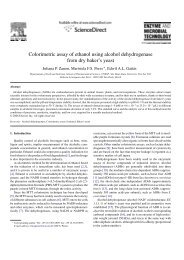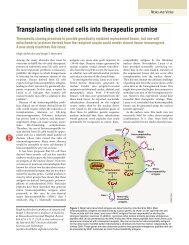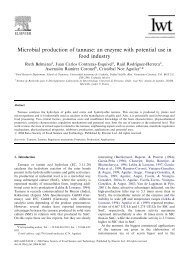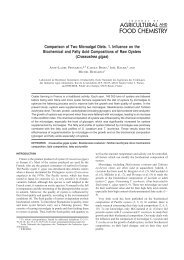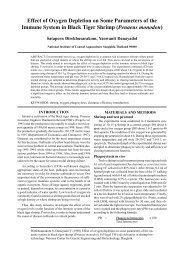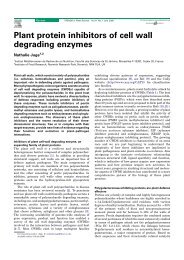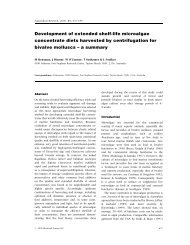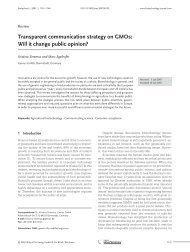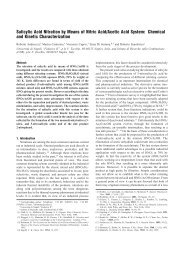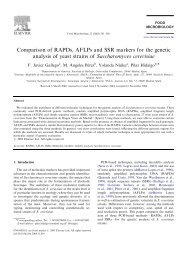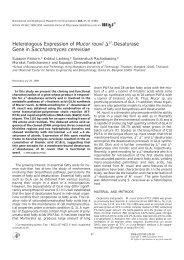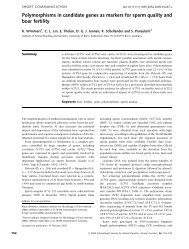Enzymatic microreactors in chemical analysis and kinetic studies
Enzymatic microreactors in chemical analysis and kinetic studies
Enzymatic microreactors in chemical analysis and kinetic studies
You also want an ePaper? Increase the reach of your titles
YUMPU automatically turns print PDFs into web optimized ePapers that Google loves.
1. Introduction<br />
Microreactors are usually def<strong>in</strong>ed as m<strong>in</strong>iaturized<br />
reaction systems fabricated by us<strong>in</strong>g, at least partially,<br />
methods of microtechnology <strong>and</strong> precision eng<strong>in</strong>eer<strong>in</strong>g<br />
(Ehrfeld et al., 2000). The term bmicroreactorQ is the<br />
proposed name for a wide range of devices hav<strong>in</strong>g<br />
small dimensions, <strong>and</strong> a further division accord<strong>in</strong>g to<br />
size <strong>in</strong>to nano, micro <strong>and</strong> m<strong>in</strong>ireactors is hardly ever<br />
used (Ehrfeld et al., 2000). Most of the currently constructed<br />
microreaction devices take advantage of microfluidics<br />
<strong>and</strong> nanofluidics, which enables use of micro<br />
<strong>and</strong> nanolitre volumes of reactive species <strong>and</strong> ensures<br />
high efficiency as well as repeatability of biocatalytic<br />
processes. Microreactors f<strong>in</strong>d applications <strong>in</strong> organic<br />
synthesis (Haswell <strong>and</strong> Watts, 2003; Hessel et al.,<br />
2004). An example of an application <strong>in</strong> biotechnology<br />
is the fast multi-step synthesis of peptides (Watts et al.,<br />
2001). The ma<strong>in</strong> benefits of application of <strong>microreactors</strong><br />
<strong>in</strong> <strong>in</strong>dustry are: faster transfer of results of development<br />
work <strong>in</strong>to production, earlier start of production<br />
at lower costs, easier scale-up of production capacity,<br />
smaller plant size, lower costs for transportation, materials<br />
<strong>and</strong> energy, <strong>and</strong> more flexible response to market<br />
dem<strong>and</strong>s (Ehrfeld et al., 2000).<br />
Though the majority of papers describe <strong>microreactors</strong><br />
as components of microfluidic devices, this term is<br />
also used <strong>in</strong> context of self-organised systems such as<br />
reverse micelles (Madamwar et al., 1988; Chop<strong>in</strong>eau et<br />
al., 1998; Carvalho <strong>and</strong> Cabral, 2000), liposomes (Oberholzer<br />
et al., 1999; Walde <strong>and</strong> Ichikawa, 2001) <strong>and</strong><br />
microemulsions (Garti et al., 1997; Garti, 2003). Selforganised<br />
systems will not be discussed <strong>in</strong> this review.<br />
Analytical systems which comprise <strong>microreactors</strong> are<br />
expected to be characterized by outst<strong>and</strong><strong>in</strong>g repeatability<br />
<strong>and</strong> reproducibility, due to replac<strong>in</strong>g batch iterative steps<br />
<strong>and</strong> discrete sample treatment by flow <strong>in</strong>jection systems.<br />
The possibility of perform<strong>in</strong>g similar analyses <strong>in</strong> parallel<br />
is an attractive feature for screen<strong>in</strong>g <strong>and</strong> rout<strong>in</strong>e use.<br />
Microreactors have been <strong>in</strong>tegrated <strong>in</strong>to automated analytical<br />
systems (Pfohl et al., 2003), <strong>and</strong> as well as provid<strong>in</strong>g<br />
benefits from system automation this also<br />
elim<strong>in</strong>ates errors associated with manual protocols. Further<br />
advantages of the use of <strong>microreactors</strong> <strong>in</strong> analytical<br />
chemistry are that they can be coupled with numerous<br />
detection techniques (Schwarz <strong>and</strong> Hauser, 2001; Verpoorte,<br />
2003a,b), <strong>and</strong> that pretreatment of the samples<br />
can be carried out on the chip (de Mello <strong>and</strong> Beard, 2003;<br />
Chiesl et al., 2005). Methods of <strong>in</strong>jection of the fluids<br />
<strong>in</strong>to microchannels, <strong>and</strong> connect<strong>in</strong>g <strong>and</strong> <strong>in</strong>terfac<strong>in</strong>g<br />
<strong>microreactors</strong> with other system components, are also<br />
be<strong>in</strong>g improved. This should help elim<strong>in</strong>ate any rema<strong>in</strong>-<br />
<strong>in</strong>g obstacles to more widespread uptake of the technology<br />
(Fang, 2004). M<strong>in</strong>iaturized analytical assays are<br />
useful <strong>in</strong> many branches of biotechnology (Guijt-van<br />
Duijn et al., 2003). The <strong>in</strong>fluence of nanotechnology <strong>in</strong><br />
the development of biosensors has been reviewed by<br />
Jianrong et al. (2004). Whilst recently published books<br />
cover <strong>in</strong>dustrial applications of <strong>microreactors</strong> (Ehrfeld et<br />
al., 2000; Hessel et al., 2004, 2005a,b), analytical applications<br />
are of <strong>in</strong>creas<strong>in</strong>g importance <strong>and</strong> are therefore<br />
also surveyed <strong>in</strong> the present review.<br />
<strong>Enzymatic</strong> <strong>microreactors</strong> have been developed <strong>in</strong><br />
order to facilitate rout<strong>in</strong>e work <strong>in</strong> bio<strong>chemical</strong> <strong>analysis</strong>,<br />
<strong>and</strong> also have applications <strong>in</strong> biocatalysis. A low expenditure<br />
of the enzyme is often a result of its immobilization.<br />
However, the range of immobilized enzymes<br />
available with satisfactory characteristics is still limited<br />
(Buchholz et al., 2005), which <strong>in</strong>evitably decreases the<br />
number of potential applications. The follow<strong>in</strong>g immobilized<br />
enzymes are used on an <strong>in</strong>dustrial scale: glucose<br />
isomerase, sucrose mutase, h-galactosidase, penicill<strong>in</strong><br />
acylase, d-am<strong>in</strong>o acid oxidase, glutaryl amidase, thermolys<strong>in</strong>,<br />
nitrilase, am<strong>in</strong>oacylase <strong>and</strong> hydanto<strong>in</strong>ases<br />
(Buchholz et al., 2005).<br />
<strong>Enzymatic</strong> <strong>microreactors</strong> have been used for analytical<br />
applications as components of <strong>in</strong>tegrated systems,<br />
often termed lab-on-a-chip or <strong>in</strong> micro total <strong>analysis</strong><br />
systems (ATAS) (Vilkner et al., 2004). Although the<br />
first enzymatic <strong>microreactors</strong> were constructed <strong>in</strong> the<br />
1970s <strong>and</strong> 1980s, the growth <strong>in</strong> their practical applications<br />
dates to the late 1990s. No examples of enzymatic<br />
<strong>microreactors</strong> were <strong>in</strong>cluded <strong>in</strong> the first comprehensive<br />
book on <strong>microreactors</strong> published <strong>in</strong> 2000 (Ehrfeld et al.,<br />
2000).<br />
It is helpful to divide the analytical applications of<br />
enzymatic <strong>microreactors</strong> <strong>in</strong>to two classes. Firstly,<br />
those which use biocatalysis <strong>in</strong> order to transform<br />
an analyte difficult to measure <strong>in</strong>to an easily measurable<br />
form. Secondly, <strong>microreactors</strong> designed for<br />
screen<strong>in</strong>g of substrates, enzymes <strong>and</strong> exam<strong>in</strong>e their<br />
k<strong>in</strong>etic characteristics. The first category is exemplified<br />
by the large number of microsystems designed<br />
for digestion of prote<strong>in</strong>s to convert them to morereadily<br />
measured peptides. Another example is oxidation<br />
of glucose by glucose oxidase followed by<br />
measur<strong>in</strong>g chemilum<strong>in</strong>escence of lum<strong>in</strong>ol oxidised<br />
by hydrogen peroxide formed <strong>in</strong> the primary reaction<br />
(L’Hostis et al., 2000). The second category is exemplified<br />
by work presented by Seong et al. (2003) to<br />
quantitatively measure enzyme k<strong>in</strong>etics <strong>in</strong> a cont<strong>in</strong>uous-flow<br />
microfluidic system.<br />
The aim of this review is to summarize recent<br />
work <strong>in</strong> the field of enzymatic <strong>microreactors</strong>, which




